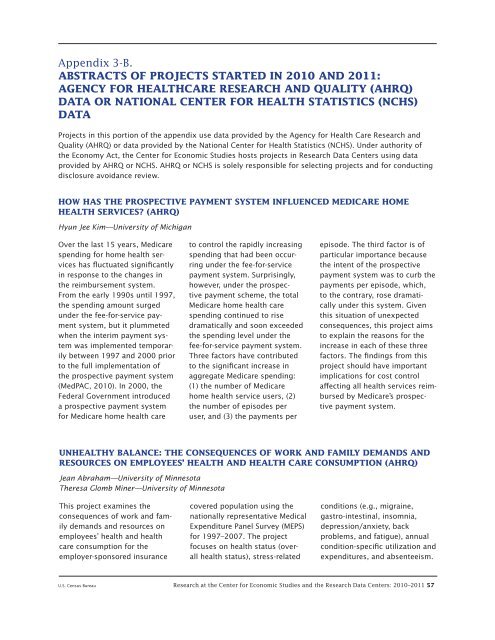2010 and 2011 - Census Bureau
2010 and 2011 - Census Bureau
2010 and 2011 - Census Bureau
Create successful ePaper yourself
Turn your PDF publications into a flip-book with our unique Google optimized e-Paper software.
Appendix 3-B.<br />
AbstrActs oF proJects stArted in <strong>2010</strong> And <strong>2011</strong>:<br />
Agency For HeAltHcAre reseArcH And QuAlity (AHrQ)<br />
dAtA or nAtionAl center For HeAltH stAtistics (ncHs)<br />
dAtA<br />
Projects in this portion of the appendix use data provided by the Agency for Health Care Research <strong>and</strong><br />
Quality (AHRQ) or data provided by the National Center for Health Statistics (NCHS). Under authority of<br />
the Economy Act, the Center for Economic Studies hosts projects in Research Data Centers using data<br />
provided by AHRQ or NCHS. AHRQ or NCHS is solely responsible for selecting projects <strong>and</strong> for conducting<br />
disclosure avoidance review.<br />
How HAs tHe prospective pAyMent systeM inFluenced MedicAre HoMe<br />
HeAltH services? (AHrQ)<br />
Hyun Jee Kim—University of Michigan<br />
Over the last 15 years, Medicare<br />
spending for home health services<br />
has fluctuated significantly<br />
in response to the changes in<br />
the reimbursement system.<br />
From the early 1990s until 1997,<br />
the spending amount surged<br />
under the fee-for-service payment<br />
system, but it plummeted<br />
when the interim payment system<br />
was implemented temporarily<br />
between 1997 <strong>and</strong> 2000 prior<br />
to the full implementation of<br />
the prospective payment system<br />
(MedPAC, <strong>2010</strong>). In 2000, the<br />
Federal Government introduced<br />
a prospective payment system<br />
for Medicare home health care<br />
to control the rapidly increasing<br />
spending that had been occurring<br />
under the fee-for-service<br />
payment system. Surprisingly,<br />
however, under the prospective<br />
payment scheme, the total<br />
Medicare home health care<br />
spending continued to rise<br />
dramatically <strong>and</strong> soon exceeded<br />
the spending level under the<br />
fee-for-service payment system.<br />
Three factors have contributed<br />
to the significant increase in<br />
aggregate Medicare spending:<br />
(1) the number of Medicare<br />
home health service users, (2)<br />
the number of episodes per<br />
user, <strong>and</strong> (3) the payments per<br />
episode. The third factor is of<br />
particular importance because<br />
the intent of the prospective<br />
payment system was to curb the<br />
payments per episode, which,<br />
to the contrary, rose dramatically<br />
under this system. Given<br />
this situation of unexpected<br />
consequences, this project aims<br />
to explain the reasons for the<br />
increase in each of these three<br />
factors. The findings from this<br />
project should have important<br />
implications for cost control<br />
affecting all health services reimbursed<br />
by Medicare’s prospective<br />
payment system.<br />
unHeAltHy bAlAnce: tHe conseQuences oF work And FAMily deMAnds And<br />
resources on eMployees’ HeAltH And HeAltH cAre consuMption (AHrQ)<br />
Jean Abraham—University of Minnesota<br />
Theresa Glomb Miner—University of Minnesota<br />
This project examines the<br />
consequences of work <strong>and</strong> family<br />
dem<strong>and</strong>s <strong>and</strong> resources on<br />
employees’ health <strong>and</strong> health<br />
care consumption for the<br />
employer-sponsored insurance<br />
covered population using the<br />
nationally representative Medical<br />
Expenditure Panel Survey (MEPS)<br />
for 1997–2007. The project<br />
focuses on health status (overall<br />
health status), stress-related<br />
conditions (e.g., migraine,<br />
gastro-intestinal, insomnia,<br />
depression/anxiety, back<br />
problems, <strong>and</strong> fatigue), annual<br />
condition-specific utilization <strong>and</strong><br />
expenditures, <strong>and</strong> absenteeism.<br />
U.S. <strong>Census</strong> <strong>Bureau</strong> Research at the Center for Economic Studies <strong>and</strong> the Research Data Centers: <strong>2010</strong>–<strong>2011</strong> 57

















